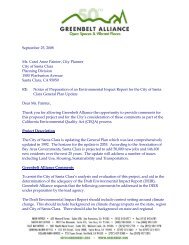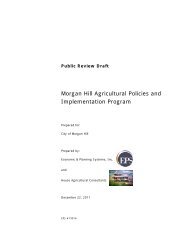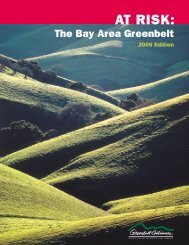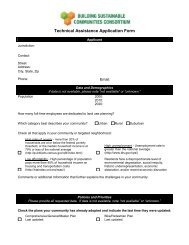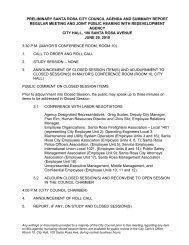Methodology - Greenbelt Alliance
Methodology - Greenbelt Alliance
Methodology - Greenbelt Alliance
You also want an ePaper? Increase the reach of your titles
YUMPU automatically turns print PDFs into web optimized ePapers that Google loves.
Below is more detail on these opportunity sites.Current Uses of Opportunity SitesMany of these opportunity sites are vacant, and others are in current use today. Of theapproximately 17,000 acres outside of Priority Development Areas, around 31% are vacant now.Others are used for residential, industrial, commercial, and other uses.Table 9: Current uses on opportunity sites likely to redevelop. 9AcresHomes(Current)Jobs(Current)Vacant 5,327 - -Residential 4,198 58,444 -Manufacturing, Wholesale, Transportation, & Other Industrial 2,808 - 38,082Retail & Other Commercial 2,225 26 45,501Other & Mixed Use 1,299 1,592 7,202Health, Education, Recreation, & Other Services 676 135 7,889Financial and Professional Service, Office 636 - 38,745Grand Total 17,168 60,197 137,420The research assumes that some buildings currently used for housing or employment could beredeveloped at some point between 2005 and 2035. Public policies are important to ensure that therelocation of these jobs and homes does not displace current residents or occur due to rapidneighborhood gentrification.The model shows some lands converting from residential to employment uses, and vice versa. Theresearch allows the Smart Growth Strategy/Regional Livability Footprint Project’s designation foran area’s future use to differ from its current use, which is taken from the California Infill ParcelLocator assessors’ parcel data. In some cases, this change in land use may happen. In others, it maynot, and the discrepancy in uses may be due to differences in the scale of the data sources. Theresearch assumes that these discrepancies would average out across the region.Place-types of the Opportunity SitesEach opportunity site falls into one of approximately twenty-five neighborhood types. A parcel’splace-type describes the character of the building and neighborhood. Descriptions of the place-typesare included in Appendix A. The results below show the distribution of opportunity sites outside ofPriority Development Areas across place-types. The results will be discussed according to severalkey building and neighborhood characteristics in the sections and tables below.9 Opportunity sites are parcels outside of PDAs likely to redevelop. This table does not reflect the redevelopmentoccurring in Priority Development Areas or as in-law apartments.17






